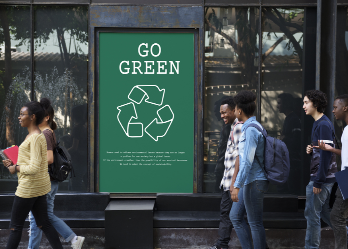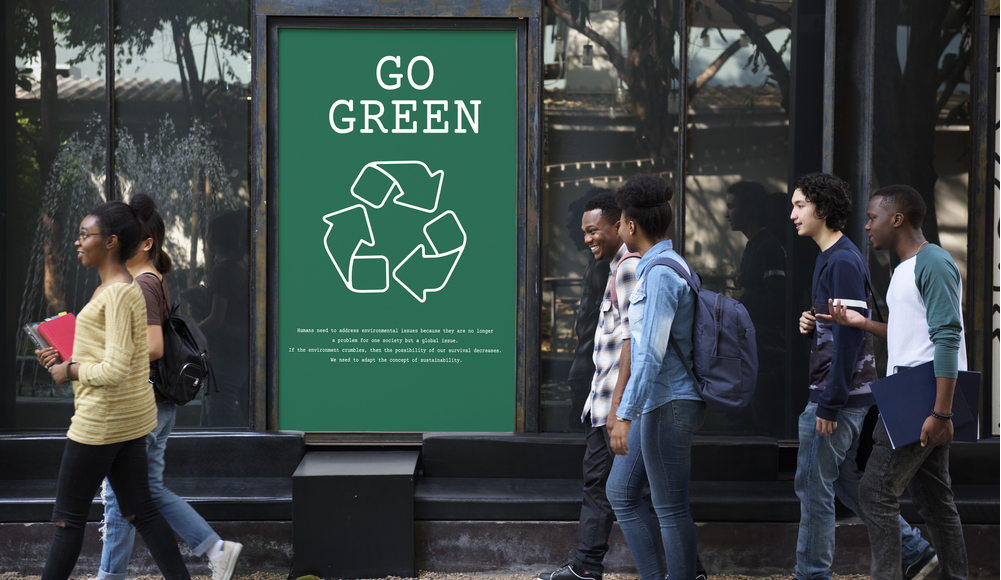
Rawpixel.com/Shutterstock
This Earth Day we learned more about a higher ed career in sustainability. Julian Dautremont, director of programs, from The Association for the Advancement of Sustainability in Higher Education (AASHE) shared his career path and experience in sustainability and what sustainability in higher education looks like these days.
Monika Sziron (HigherEdJobs): What is your role at AASHE? How did you get to your role/what was your career path? And tell us more about your career and how it’s affiliated with higher education.
Julian Dautremont (AASHE): Let me start with a background of what AASHE is. AASHE is an international network of colleges and universities that are working towards sustainability. And our role is really to help members learn from one another. We do all the types of things that other associations do. We have a conference, we have online resources, we have publications, we have a newsletter. And they’re all designed to help members learn from another. Our flagship program, which also has the same ultimate objective is something called STARS, the sustainability tracking assessment and rating system. It’s a tool that hundreds of campuses use to measure and report on their sustainability performance. It allows them to benchmark with other institutions, measure progress over time, and report to their stakeholders on all the great work that they’re doing. My role as director of programs is really to help coordinate and support all those programmatic outputs.
I studied environmental studies as an undergrad, so I knew I wanted to go into the sustainability field in some respect. I was involved in the sustainability efforts at my campus, but when I graduated I was not particularly interested in staying in higher ed. I got a scholarship to study sustainable development for small island countries in Barbados for a year and ended up helping found a bio-diesel company using waste vegetable oil from restaurants and cruise ships. It was a really valuable experience, but it helped me see that international development was not the field for me. After I got back to the US, I ended up helping to found this organization [AASHE] and served as it’s Associate Director for 4 years. I left for graduate school in 2009 at the University of Michigan, where I earned a dual degree in business and sustainability.
In my time at AASHE, I’d come to understand that higher ed has a unique and important role to play in society and that it could be a powerful leverage point for advancing sustainability. Virtually all of the decision-makers in large corporations, governments, and cultural institutions go through a higher education institution and in the US there’s only around 4,000 of them. If they are all modeling sustainability in their operations and incorporating sustainability in their research, curricula, and co-curricular activities, that could have a huge potential spillover effect on the knowledge, skills, motivations, and understandings of all these decision-makers. So, after I graduated, I was excited to find a job as the chief sustainability officer at Alfred State College. I spent two years there working on a number of different things to advance Alfred State’s sustainability performance. After moving for family reasons, I worked at a consulting firm called GreenerU for about a year before returning to AASHE in my current role in 2015.
Sziron: What are some best practices in sustainability buy-in from all sectors of campus? If you’re trying to get executive leadership to buy-in, staff to buy-in, students to buy-in, what are some best practices that you’ve seen institutions do to really get everybody on board with sustainability?
Dautremont: In general, we see students tend to be pretty on board already. In many cases, students are the reason that institutions are emphasizing sustainability in the first place. There is actually quite strong evidence that prospective students care about sustainability and use that as a decision-making criterion. For example, The Princeton Review does surveys of incoming students every year. Since 2007 or ’08, they’ve included a question something along the lines of, ‘how does an institution’s environmental leadership impact your decision to apply or attend?’ The results have been fairly consistent, with a slight increase in recent years, but somewhere around a quarter of prospective students say sustainability matters a great deal. Two thirds say it matters at least somewhat.
So this is part of what I think is driving attention from higher education leaders, who know that sustainability is a concern for a sizable segment of the students that they’re hoping will enroll. Faculty and staff often have their own priorities, but also tend to be at least open to sustainability. I think everybody would like to work for organizations that are doing good.
A general best practice for building support is to incorporate stakeholder engagement in the development of sustainability plans. It’s not effective to just have somebody in the sustainability office write a plan and hand it over to the president or the board of trustees. That plan is going to go nowhere. There’s a lot of attention in our community to designing processes to ensure that the campus community has a meaningful voice in that plan and is therefore much more likely to feel bought in. Those kinds of things really help build buy-in and just demonstrate transparency and inclusion that are good things anyway.
Another thing that can help with faculty and staff is using the campus itself as a living laboratory. The physical campus has all these opportunities for sustainability education, but they’re often not used in that way. For example, students could study the biodiversity of campus grounds in their biology classes. Engineering students could investigate the efficiency of campus buildings. There are many similar opportunities for collaboration between staff and faculty that provide students with experiential education in sustainability.
Sziron: What are some of the biggest changes you’ve seen in the last 20 years when it comes to sustainability in higher education?
Dautremont: The field of campus sustainability starts with student activists realizing being that their institutions seem to be creating, or at least contributing to, the social and environmental problems that they were learning about in the classroom. As a result, a variety of different student movements emerged to advocate for things like reducing carbon emissions, paying living wages to employees, and making sure that the apparel with the institution’s logo on it is not made in a sweatshop. All these different movements serve to raise the visibility and perceived importance of institutional social and environmental responsibility. They also helped higher education decision makers to understand that they needed somebody at their organization to be attentive to these issues. Some institutions have tried to use voluntary committees of staff to advance their sustainability work, especially at first, but generally, they find that they need someone on staff who can make sustainability a consistent focus if they are going to be able to make real progress.
So, the field starts with all these activists demanding things like carbon neutrality and institutions then attempting to meet those demands by hiring sustainability staff. As more and more of these positions are hired, a whole new profession begins to take shape. We’re at the point now where different sub-specializations have emerged. For example, there are higher education sustainability staff who focus on communications and outreach and others who focus on measurement and reporting. As the field has professionalized, it’s also become much more technical and more detailed as sustainability staff work to figure out how to actually achieve the ambitious sustainability goals their institutions have set.
The other major shift in the field over the last couple decades is a realization that sustainability is no longer seen as optional for many institutions. The conversation now is less about whether or not sustainability should be a goal, and more about how to achieve it. That’s a real sign of progress.
Sziron: What would be your ideal Earth Day celebration on campus?
Dautremont: We always sort of encourage our community to think of events like Earth Day as an opportunity to make some kind of new announcement of institutional action. It’s easy to get caught up in the individual volunteerism kind of stuff like tree plantings or litter clean ups. That kind of thing is important, but it’s unlikely to be sufficient in catalyzing the changes that we need. We need much more significant action at a higher scale. So, you can still have a nice concert on Earth Day, but as part of it, perhaps the college president could announce a new initiative or commitment. In other words, you try to pair the fun hands-on stuff with something that is driving action at a higher level.
I do like the teach-ins that institutions do where they encourage faculty to devote a day of class to discuss how the course material or their discipline more generally relates to sustainability. That’s a neat way to reach a different population of students and help them to understand how sustainability is likely to impact their career.
Sziron: What advice would you have for anybody looking to work in sustainability in higher ed? How can someone be most prepared to jump into this field right now?
Dautremont: I think the most helpful thing, if you are still in college or graduate school, is to get involved in your campus and to gain some experience in campus sustainability. Even when we’re hiring interns, having actual experience doing this work very clearly sets a candidate apart. Experience with sustainability in a different sector can help as well, but higher ed is a bit of a unique space so there are some real advantages to being experienced in a higher ed context.
In terms of academic study, it used to be there weren’t very many degrees in sustainability. As a result, when you look at the current group of sustainability directors and chief sustainability officers, their academic backgrounds are pretty diverse. There are folks who were trained as planners, architects, engineers, biologists, and more. I think that’s starting to be the less common as there are now more candidates with the master’s degrees in sustainability or even PhDs in sustainability.
It’s definitely still possible for people with other academic backgrounds to get into higher ed sustainability but you do have to supplement your academic program with other work in sustainability to demonstrate sustainability expertise. There are some professional credentials emerging that may be worth looking into.
The other thing to be aware of is that there aren’t that many higher education sustainability jobs. It’s not a huge field; much narrower than corporate sustainability for example. As a result, finding a job in this space will likely require some patience and/or flexibility in terms of where you live.
If you’re trying to stay on top of what opportunities are available, the AASHE bulletin includes a few new sustainability jobs each week. I should mention too, that every few years we’ll do a survey of sustainability professionals in higher ed to understand their salaries, how many years of experience they have, and a whole variety of other information about the profession. One last thing to note for folks who want to work in this field — in most cases you should expect to work with students and be excited about that. There will be technical parts of the job, but it’s likely that your work will interface with students quite significantly. Inspiring and supporting students to be sustainability leaders is an important part of the job. That is a real difference from most other kinds of professional sustainability jobs. It’s part of what a lot of people love about the higher ed sustainability field.
